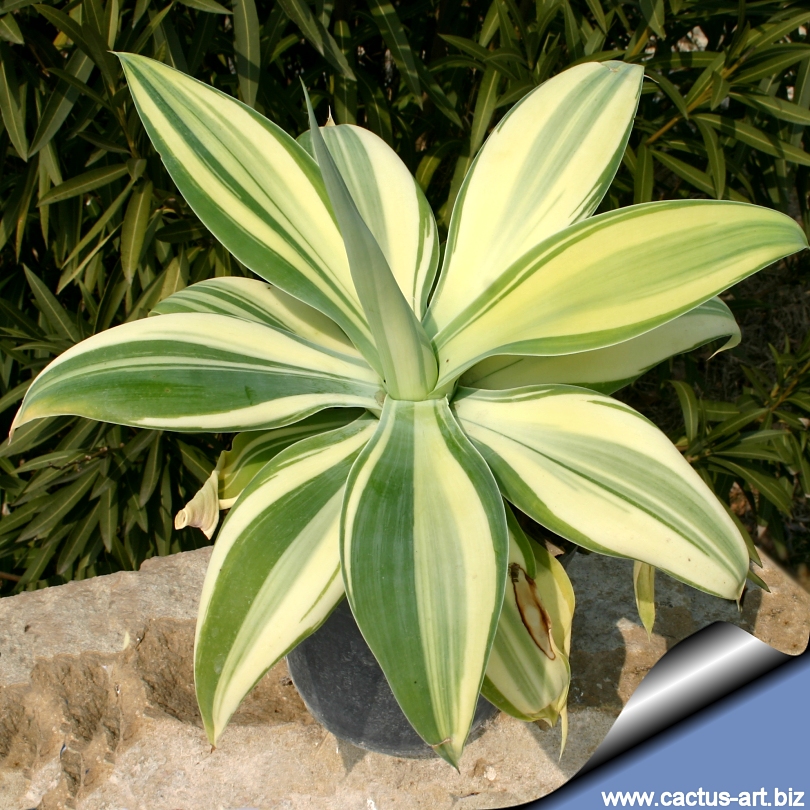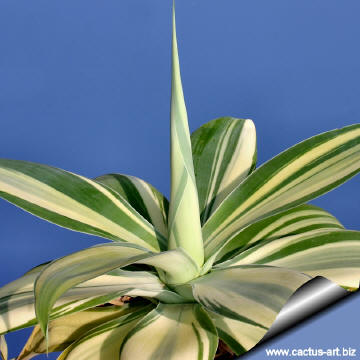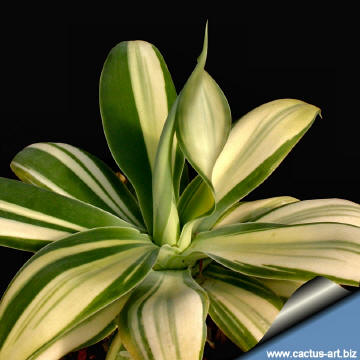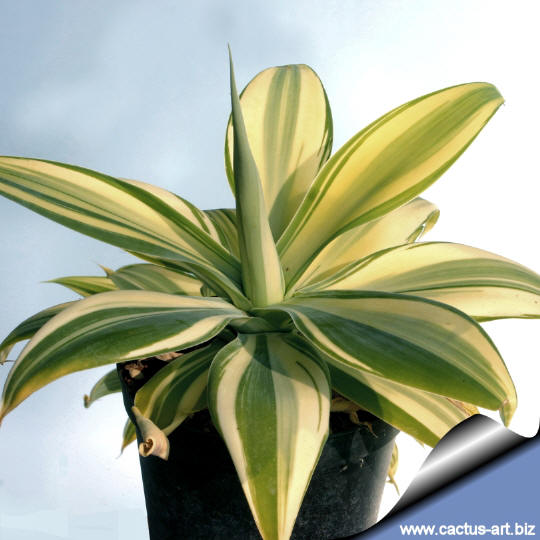|
|
|

The variegated Agave attenuata are
among of the much
sought after and highly prized
agaves by collectors, but they are very expensive.
|
|
Description:
A. attenuata “variegata”
is a wimpy, but striking and very pricey plant, it is basically same as
regular A.
attenuata except for the broad, soft, pale blue-green leaves
that are marked with contrasting creamy yellow stripes. This cultivar
tends to be slower to offset and doesn't seem to grow as fast or get as
large. It is thought that it can takes a lot of sun for a variegated
plant but a filtered sun spot is surer.
The degree of variegation varies considerably from plant to plant, some
are almost completely green with only few thin cream stripes while - on
the other extreme - we can found almost completely white ones. The
whiter leaved are the more admired and pricey, but also the slower and
difficult to grow, especially the very white ones. It makes for a
handsome potted plant, especially when highlighted with dark foliage
plants such as Black Aeonium. If planted in the ground it will likely
form a clump to 90 to 120 cm or more tall by even wider with many
rosettes of leaves. Fear not this plant as it has no spines unlike
its prickly cousins.
Stems: Stout curving , often
branched, smooth grey stems that rise up to 100 cm tall (unusual among
agaves) and eventually old leaves fall off, leaving them naked and
visible.
Leaves: Wide, soft,
pliable, somewhat translucent ovate-accuminate,
50-70 cm long and 12-16 cm large. The leaves are powdery green, light
yellowish green or grey/blue green.There are no teeth, nor terminal
spines, although the leaves taper to points that fray with age. They
emerge from a tight central spear to arch gracefully back, looking a bit
like a large open green flower.
Flowers: Flowers are pale greenish yellow on a dense raceme
1,5-3,5 long .
Over
many months the
vertical flower stalk
develops,
first
as a mass of green buds which open from the bottom up into flowers of
greenish-yellow, then
it reflexes back towards the ground before arching upward again. The
flowers are followed by seed pods and from
the axils of the flowers many new "plantlets" (or bulbils) will sprout,
meanwhile the mother rosette slowly dies. But sometime - unlike
other members of it's family - this plant doesn't die after flowering.
Blooming Time:
Spring. It may take up to 10 years to bloom.
|
 |
 |
|
Advertising
|
|
|
|
|
Family: Agavaceae
Scientific Name: Agave attenuata Galeotti 1834
forma variegata
Origin:
Garden origin (Nursery
produced cultivar)
Synonyms:
- Agave cernua Berger 1915
- Agave glaucescens Hook. 1862
- Agave pruinosa Lem. ex Jacobi 1865
Common English Names include: " Variegated Fox Tail Agave", "Variegated Lion's
Tail", "Variegated Swan's Neck", "Variegated Elephant’s trunk", "Variegated Spineless
Century Plant", "Variegated
Gooseneck Succulent" and "Variegated
Soft Leaved Agave".
|
|
|
|

The
variegated plants are very very hard to propagate, and they almost never
have pups, the little offsets that grow at the base of the plant.
Cultivation:
Agave
attenuata is an
excellent plant which works well with other succulents or even tropical
plant material. It is well suited for a container inside or a sheltered
warm spot outdoors.
It is a frost tender plant and
it will usually be
severely damaged in temperatures below -2° C.
Although
Agave attenuata
survives in poor soils and can tolerate
full coastal sun to to full shade,
it does best in rich but
well-drained soil mix
( 2 parts peat moss to 1 part loam to 1 part of pumice) with half sun
exposures. The plant is extremely drought tolerant but does better with
ample moisture
and grows quickly if kept
well watered and nourished (Slow release fertilizer applied once or
twice a year is usually sufficient).
During the winter months, one should only water enough to keep the
leaves from shrivelling. Plants cultivated outdoors are more drought
tolerant and can take some heat and full sun.
It
tolerates seaside conditions too.
Protect
from snails which can also disfigure the plant.
Offsets or
'pups' can be removed to maintain the strong architectural lines of the
Agave and provide great additional plants, or left to form a clump.
Propagation:
By seeds or by
removing
suckers
produced at the
base of older plants or using
the thousands
of small bulbils produced on its' entire flower stalk length. Seeds
germinate readily when they are fresh.
The basal suckers can be removed in spring or summer,
letting the cuttings dry for a few days before inserting in compost.
Photo of conspecific taxa, varieties, forms and
cultivars of Agave attenuata.

 |
|